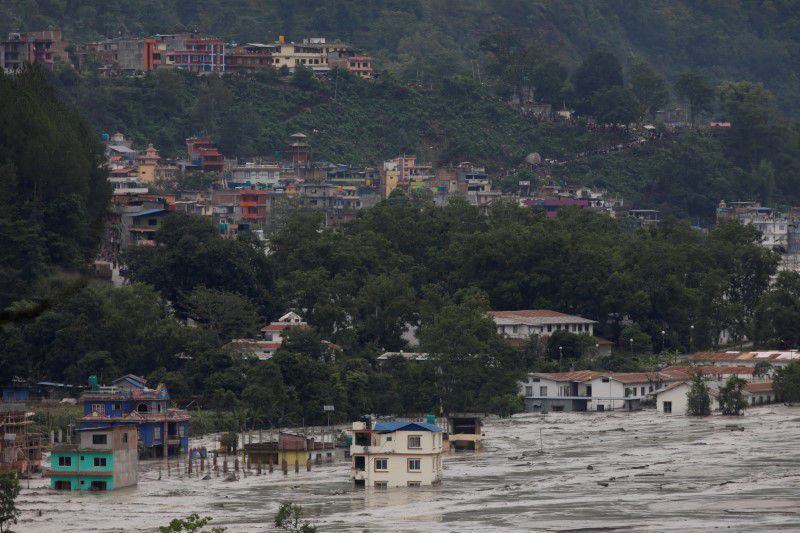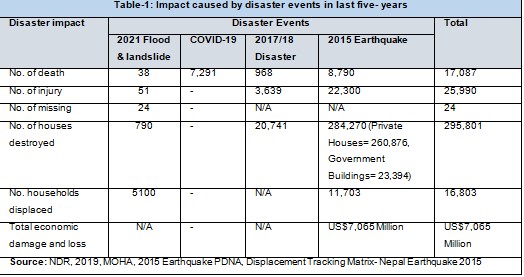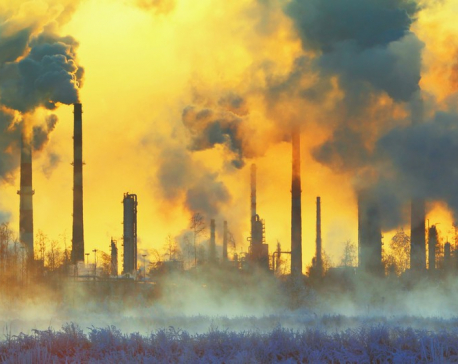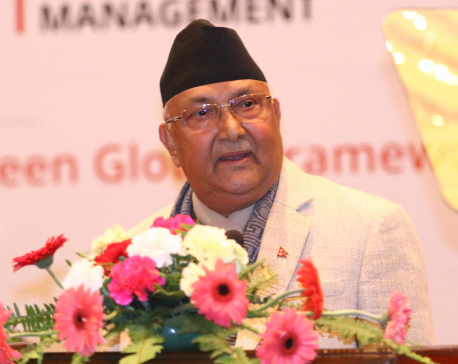
OR
Opinion
Disaster and climate risks and sectoral development planning
Published On: July 15, 2021 12:59 PM NPT By: Bimal Gadal

More from Author
There has been a paradigm shift in the understanding of disaster risks, exposures, vulnerabilities, and their management. Disaster risk reduction, emergency preparedness, and mitigation are getting more attention than the traditional rescue, relief, and rehabilitation with the former one the cost-effective and efficient measures to save lives and properties in the aftermath of a disaster.
Nepal is a hotspot of many natural as well as climate-induced disasters including earthquakes, landslides, flood, fire, heat waves, cold waves, lightning, windstorms, hailstorms, droughts, epidemics, etc, which has pushed more than 80 percent of the total population to live with risks. (NDR, 2019). According to the Global Climate Risk Index, GERMAN WATCH Report 2020, Nepal ranks 10th in terms of long-term climate risk impact with a CRI Score of 31.33. Similarly, the Word Bank Report 2011 has ranked Nepal 11th in terms of earthquake risk and 30th in terms of flood risk.
The combination of rugged topography, active tectonic process, and intense monsoon has created a fragile environment pushing Nepal into more vulnerability and increased disaster risk in a number of ways intensifying the magnitude and frequency of extreme events. Nepal has changed its paradigm from a centrally managed system to a federal mechanism decentralizing its power from central to the province and down to the urban and village Municipalities. As new threats are generated, for which, the newly set up political structures/systems and communities may have no experience in dealing with. Hence, it calls for a comprehensive, system-based, and sustainable disaster and climate risk management approach that includes both Disaster and Climate Risk Reduction strategies for attaining the Sendai Framework for DRR, Addis Ababa Action Agenda of the Third International Conference on Financing for Development, Paris Agreement, and Agenda for Humanity, the New Urban Agenda and the Sustainable Development Goals.
The Government of Nepal committed to the implementation of the Sendai Framework for Disaster Risk Reduction 2015-2030 at the Third United Nations World Conference (March 2015) on Disaster Risk Reduction, AMCDRR in New Delhi and Ulaanbaatar, to enhance efforts to strengthen disaster and climate change risk reduction to reduce losses of lives, livelihoods, and assets from disasters, increase the capacity for understanding about the disaster risks, strengthen the global and regional cooperation for DRR and establish multi-hazard risk information management system for potential disasters. Accordingly, the government prepared a new roadmap for a post-2015 framework to address priorities under Sendai Framework for DRR.
Taking into account the experience gained through the implementation of the Hyogo Framework for Action: 2005-2015/NSDRM, lessons from the 2015 Gorkha Earthquake, recent floods and landslides, COVID-19, and other existing/emerging initiatives around Climate Change and Sustainable Development Goals, Government of Nepal has prepared and endorsed the Disaster Management Act 2017, National Disaster Risk Reduction Policy (2018), and National Disaster Risk Reduction Strategic Action Plan (2018-2030), established National Disaster Risk Reduction and Management Authority and the focal desk for DRM within the line ministries at federal, provincial and local levels and has established national multi-stakeholder platform for DRR aiming at to improve overall DRM capacity and coordination mechanism at various levels. In addition to this, hundreds of national and international non-government organizations, donor agencies, individuals, and private sectors are investing millions to support the government’s efforts in DRM and resilience building.
Despite all these efforts, every year flash floods and landslides triggered by torrential rains across Nepal are paralyzing public life so badly taking away the lives and injuring many, destroying the houses, critical infrastructures, public properties, agricultural land, and disrupting the economy.

Recent floods and landslides that occurred across the country caused widespread damage and loss including death, several injuries, inundated hundreds of houses, destroyed homes, bridges, roads, and agricultural land causing displacement of many and serious economic disruptions. Similarly, COVID-19, which was first identified in Nepal on the 13th of January, 2020 has crippled everyday life. Since it was first identified, the total caseload has reached 648,085 and 9,263 fatalities (as of July 6, 2021). Similarly, on 25th April 2015, a 7.8 magnitude earthquake hit Nepal, followed by a 7.3 magnitude earthquake on 12th May 2015, causing massive loss and damages to human lives, properties and the economy. Human and economic loss, physical damage, and disruptions on the economy caused by some of these disasters amplify the poverty and human sufferings to the extreme, challenging for the timely achievement of the SDG targets (Table-1).
Much of the mountainous terrain in Nepal lies in the tectonically active zone and has a fragile geological structure. The steepness of slopes and the swift flow of water bodies make the geography susceptible to landslides triggered by the monsoon’s heavy rains. Changes in rainfall patterns which have become severe and erratic are contributing to extreme landslide events. Growing populations, illegal settlements in hazard-prone areas, and haphazard road constructions are also triggering landslides in the hilly areas. Unplanned development of urban centers has posed additional risks triggering many negative multiplier effects.
Apart from this, there lies the institutional challenge with newly elected bodies and officials in place. The government of Nepal has endorsed the DRRM Act opening doors to cover all stages of DRM making local government structures more accountable to manage their local disaster and climate change risk without sufficient legal and policy framework at the local level. There is no consistent legal mechanism to relocate individuals or communities from high-risk areas to safer areas but relocation exists on an ad hoc basis, primarily in response to a particular disaster. Although there is a growing emphasis on disaster risk reduction in Nepal, there is not yet a comprehensive and system-based Disaster Management approach in place. There is no comprehensive or adequately resourced mechanism to implement the Disaster Risk Reduction and Management Act 2074, Local Self Governance Act 2074, and National Building Codes (NBC) to guard against the risks of earthquake, flood, landslide, and fire. Land use planning is not clearly regulated. There are many cross-boundary issues such as flood risk management and climate change, but the coordination at the cross-boundary and cross-sector levels is lacking.
As they are provisioned by Nepal’s Constitution followed by the Disaster Risk Reduction and Management Act 2074 and Local Self Governance Act 2074, provincial governments can play a major role in coordinating and mediating actions between the federal and local governments, which seems to be lacking in the present scenario. Government authorities at all levels have the authority to develop and implement Risk Sensitive Land-use Planning (RSLUP) based on the level of exposure of life, livelihood, economy, and physical infrastructure to the local hazards and risks. In particular, local governments have the authority to prepare hazard maps and vulnerability profiles, RSLUP and implement contingency plans, and disseminate early warning messages. Sadly saying, Nepal’s disaster risk management practices and mindsets are still heavily influenced and occupied with the former Disaster Relief Act 2039 and are not convinced yet to invest in pre-disaster initiatives, therefore, incurring the level of damage and loss not at the acceptable level.
Much has to be learned from the past and ongoing disaster events. There has been a paradigm shift in the understanding of disaster risks, exposures, vulnerabilities, and their management. Disaster risk reduction, emergency preparedness, and mitigation are getting more attention than the traditional rescue, relief, and rehabilitation with the former one the cost-effective and efficient measures to save lives and properties in the aftermath of a disaster. Failure to factor these into the sectoral development planning process, will simply pushthe nation back into poverty and debt making SFDRR and SDG targets hard to achieve.
You May Like This

True Price of Carbon
NEW YORK – At the center of many policy challenges is a contest between “realists” and “radicals.” That’s true of... Read More...

The 10 climate-change disasters in 2018 that caused damage worth US$85 billion
From California’s worst wildfires in history to Hurricanes Florence and Michael, the world’s top ten climate-linked disasters this year caused... Read More...

Govt is serious about disaster risk management: PM Oli
KATHMANDU, Dec 3: Prime Minister KP Sharma Oli has said that the government has been working on preparedness regarding the disaster... Read More...




Just In
- CM Kandel requests Finance Minister Pun to put Karnali province in priority in upcoming budget
- Australia reduces TR visa age limit and duration as it implements stricter regulations for foreign students
- Govt aims to surpass Rs 10 trillion GDP mark in next five years
- Govt appoints 77 Liaison Officers for mountain climbing management for spring season
- EC decides to permit public vehicles to operate freely on day of by-election
- Fugitive arrested after 26 years
- Indian Potash Ltd secures contract to bring 30,000 tons of urea within 107 days
- CAN adds four players to squad for T20 series against West Indies 'A'















Leave A Comment